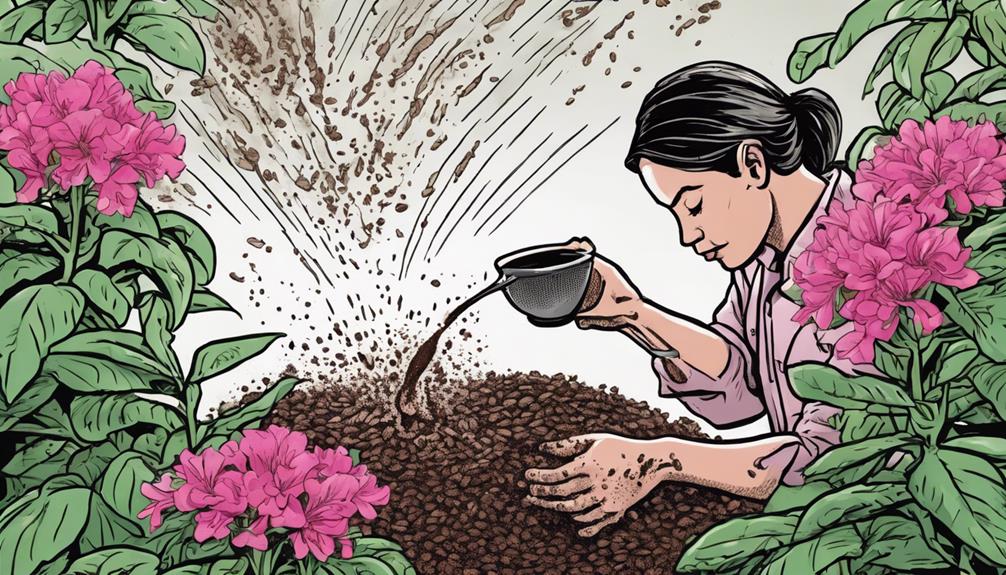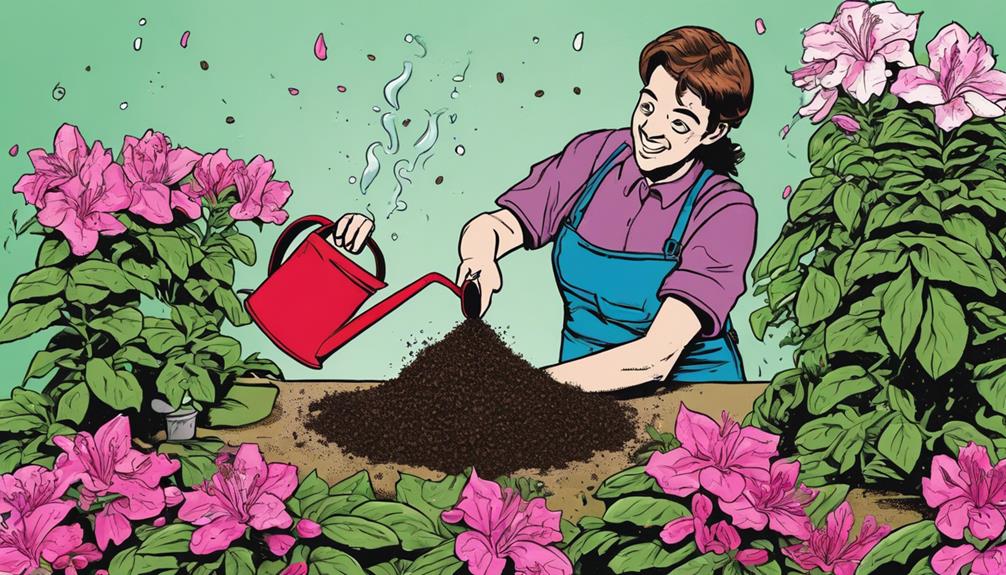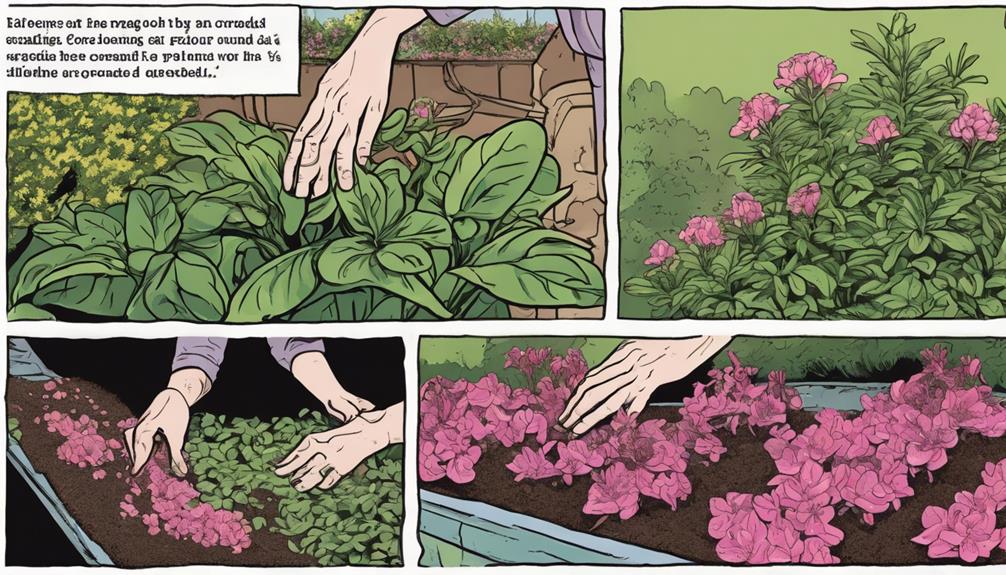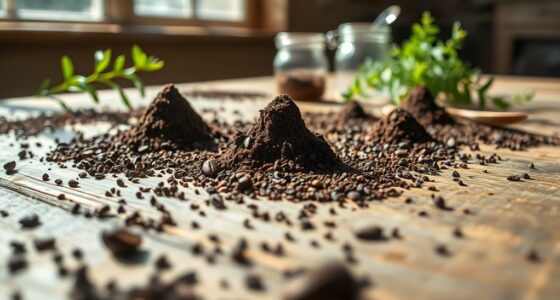Improve the health of your azaleas by using coffee grounds around the plants while avoiding direct contact with the stems. Make sure the grounds are completely dry before using them for maximum benefits. Mix them into the soil to enhance drainage and provide nutrients. Coffee grounds offer essential nutrients, help balance acidity, improve soil quality, and repel pests. To promote optimal growth, combine the grounds with compost, use them sparingly, and apply as mulch. By applying the grounds around the base of the plants, you can boost azalea growth and prevent weeds. Consider adding wood ash for increased acidity. Make the most of your azaleas’ potential by strategically using coffee grounds.
Key Takeaways
- Apply coffee grounds around azalea base for slow-release nutrients.
- Avoid direct contact with plant stems to prevent rot.
- Use dried grounds as mulch for moisture retention and soil enrichment.
- Mix grounds into soil for improved drainage and acidity balance.
- Regularly integrate coffee grounds to promote vibrant blooms and overall plant health.
Benefits of Using Coffee Grounds for Azaleas
Benefit your azaleas by incorporating coffee grounds into their soil to provide necessary nutrients and promote healthy growth.
When used around azaleas, coffee grounds offer a range of benefits. To start with, they enhance soil quality, providing a rich source of slow-release nutrients that are crucial for your azaleas' development. The nitrogen content in coffee grounds is particularly advantageous, fueling healthy growth and lush foliage.
Additionally, the natural acidity found in coffee grounds aligns well with the preferences of acid-loving azaleas, making it an ideal choice for improving their overall health.
By incorporating coffee grounds around your azaleas, you aren't only providing them with essential nourishment but also setting the stage for vibrant blooms and thriving plants.
Embrace the advantages of using coffee grounds to bolster your azaleas' well-being and witness the remarkable difference it can make in their growth and robustness.
Best Practices for Applying Coffee Grounds

Enhance the health and growth of your azaleas by following these top practices for applying coffee grounds. When spreading coffee grounds around your plants, make sure they are not directly touching the plant stems. Use the grounds as a mulch to help retain moisture and suppress weeds around your azaleas. Incorporate the coffee grounds into the soil to promote healthy drainage and improve nutrient content. It's essential to let the coffee grounds dry completely before applying them to prevent any potential issues.
To help you visualize the top practices for applying coffee grounds to your azaleas, consider the table below: Below is a breakdown of the ideal amounts and frequencies for applying coffee grounds to your azaleas, allowing you to customize your plant care routine to best suit your garden. Additionally, it can be just as beneficial to apply coffee grounds to hydrangeas, as they also thrive in acidic soil and can benefit from the nutrients found in coffee grounds. By incorporating these best practices, you can ensure that your azaleas and hydrangeas receive the nourishment they need for healthy growth and vibrant blooms.
| Top Practices for Applying Coffee Grounds | |
|---|---|
| Apply the coffee around your plants | Ensure the grounds do not touch plant stems |
| Let the coffee grounds dry completely | Use as a mulch for moisture retention |
| Incorporate into the soil | Promote healthy drainage and nutrient content |
Incorporating Coffee Grounds for Azalea Health

To enhance the health of your azaleas, consider incorporating coffee grounds into the soil for added nutrients and improved soil quality. Using coffee grounds around your azaleas offers multiple benefits. They provide essential nutrients like nitrogen and potassium, necessary for healthy growth.
Additionally, coffee grounds help balance soil acidity levels, which is advantageous for these acid-loving plants. The organic matter in coffee grounds enhances soil structure, improving drainage and water retention, creating a healthy environment for azaleas to thrive.
Furthermore, coffee grounds act as a natural pest repellent, safeguarding your azaleas from harmful insects and pests. To ensure your azaleas receive these benefits, regularly integrate coffee grounds into the soil around them.
Tips for Maximizing Azalea Growth

Maximize the growth of your azaleas by implementing these effective tips for best health and vibrancy. Azaleas can benefit greatly from the essential nutrients found in coffee grounds.
To optimize growth, apply coffee grounds around the base of your azaleas, making sure they don't come into direct contact with the plant stems. You can also mix coffee grounds with soil or compost to provide your azaleas with a rich source of nutrients from your kitchen scraps.
Using coffee grounds as a mulch around your azaleas not only retains moisture in the soil but also helps deter pests that may harm your plants. Remember, moderation is key when using coffee grounds for your azaleas to avoid over-fertilization, which can have adverse effects on their growth.
Enhancing Azaleas With Coffee Grounds

By incorporating coffee grounds around your azaleas, you can greatly enhance their growth and overall health. Here are some tips to make the most of this natural fertilizer:
- Apply coffee grounds directly: Spread used coffee grounds around the base of your azaleas, ensuring not to mound them against the plant's stem. This will help maintain the preferred soil pH levels for your azaleas.
- Use coffee grounds regularly to aerate: The organic matter in coffee grounds attracts earthworms, which help aerate the soil and improve its structure. Regular applications can lead to better water retention and overall plant health.
- Enjoy numerous benefits: Coffee grounds act as a slow-release fertilizer, providing essential nutrients over time. They also assist in controlling weeds, retaining moisture, and promoting healthy growth for your azaleas.
- Consider adding wood ash: Mixing wood ash with your coffee grounds can further enhance the soil's acidity, aiding in the best growth of your azaleas. Remember to use a balanced mixture for the best results.
Frequently Asked Questions
How to Apply Coffee Grounds to Azaleas?
To apply coffee grounds to azaleas, spread them around the base for natural nutrients. Improve soil acidity by using coffee grounds as mulch to retain moisture and deter pests. Incorporate grounds into the soil for healthy roots. Similar to azaleas, hydrangeas can also benefit from the natural nutrients found in coffee grounds. Apply coffee grounds to hydrangeas by spreading them around the base of the plant to improve soil acidity, retain moisture, and keep pests at bay. By incorporating coffee grounds into the soil, you can help promote healthy root growth and overall plant health for your hydrangeas.
Do You Just Sprinkle Coffee Grounds on Plants?
Don't just sprinkle coffee grounds on plants. Mix them with soil or compost first! It helps prevent mold, nutrient barrier, and promotes gradual release. Incorporating grounds properly guarantees breakdown and nutrient utilization by azaleas.
What Plants Should You Not Put Coffee Grounds Around?
You should not put coffee grounds around plants that prefer alkaline soil like lilacs and tomatoes, those sensitive to caffeine such as geraniums, herbs like parsley that dislike acidic conditions, succulents, cacti, and plants prone to fungal diseases like cucumbers and squash.
How Do You Add Coffee to Plants?
To add coffee to plants, sprinkle grounds around the base for nitrogen. Be cautious not to overdo it, as too much nitrogen can harm plants. Mix with compost or soil for better absorption. Regular use improves soil quality.
Conclusion
So, next time you brew up a fresh pot of coffee, don't throw away those grounds – sprinkle them around your azaleas instead!
Not only will they provide essential nutrients for your plants, but did you know that coffee grounds can also help repel pests like slugs and snails?
Give your azaleas a boost with this simple and eco-friendly gardening hack!









